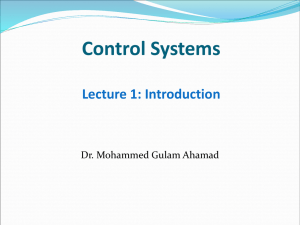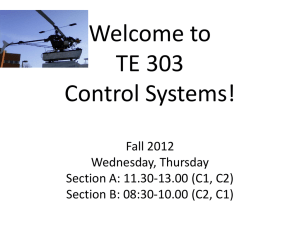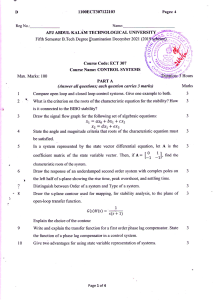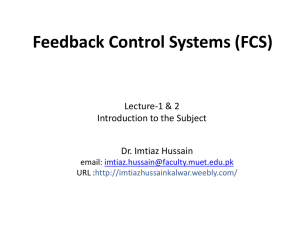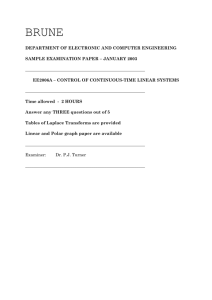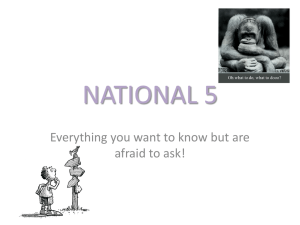Dowload File - Dr Muhammad Arif
advertisement
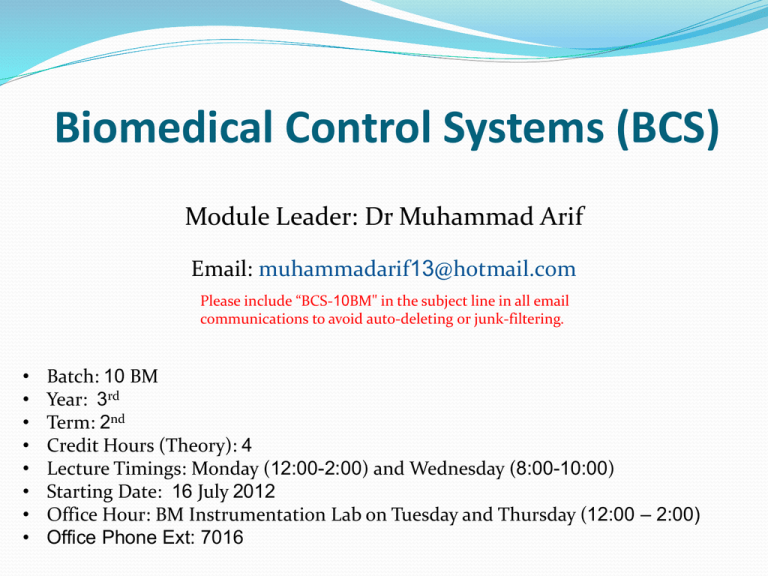
Biomedical Control Systems (BCS) Module Leader: Dr Muhammad Arif Email: muhammadarif13@hotmail.com Please include “BCS-10BM" in the subject line in all email communications to avoid auto-deleting or junk-filtering. • • • • • • • • Batch: 10 BM Year: 3rd Term: 2nd Credit Hours (Theory): 4 Lecture Timings: Monday (12:00-2:00) and Wednesday (8:00-10:00) Starting Date: 16 July 2012 Office Hour: BM Instrumentation Lab on Tuesday and Thursday (12:00 – 2:00) Office Phone Ext: 7016 Course Outline • • • • • • • • • • • • • • Open loop and close loop control systems. Block diagrams models and reduction techniques. Signal flow graphs. Mathematical modeling of electrical and mechanical systems. Transient and steady state response of linear control systems. State-space representation and analysis. Eigen values and Eigen vectors. Closed-loop system stability analysis using the Routh-Hurwitz criteria. Stability, performance analysis, and control system design using the Root Locus techniques. Bode diagrams. Polar plots. Nyquist stability criterion. Gain and Phase margins. Nichol’s chart. Objectives of BCS On completion of this module, students will be able to do the following ; • • • • • • • • • • Define the basic terminologies used in controls systems. Explain advantages and drawbacks of open-loop and closed loop control systems. Obtain models of linear control systems in ordinary differential equation, transfer function, state space, or block diagram form. Obtain overall transfer function of a linear control system using either block diagram algebra, or signal flow graphs. Simplify complex control system models using block diagram and signal flow graphs reduction techniques. Explain the relationship between system output response and transfer function characteristics or pole/zero locations. Determine the stability of a closed-loop control systems using the Routh-Hurwitz criteria. Analyze the closed loop stability and performance of control systems based on open-loop transfer functions using the Root Locus technique. Compute and analyze the frequency response of control systems using Bode diagrams. Analyze the closed loop stability and performance of control systems based on open-loop transfer functions using the Polar plots and Nyquist stability criterion techniques. Text Books 1. Schaum’s Outline of Feedback and Control Systems, (2nd Edition) By: Joseph J. Distefano, Allen R. Stubberud, and Ivan J. Willaims. 2. Modern Control Engineering, (5th Edition) By: Katsuhiko Ogata. 3. Control Systems Engineering, (6th Edition) By: Norman S. Nise. Reference Books 1. Modern Control Systems, (12th Edition) By: Richard C. Dorf and Robert H. Bishop. 2. Basic Feedback Controls in Biomedicine. By: Charles S. Lessard. 3. Feedback Control Systems, (4th Edition) By: Charles L. Phillips and Royce D. Harbor. 4. Automatic Control Systems, (9th Edition) By: Golnaraghi and Kuo. 5. Feedback Control of Dynamic Systems, (6th Edition) By: Gene Franklin, J.D. Powell, and Abbas Emami-Naeini Marks Distribution Total Marks = 100 Sessional Marks = 20 • Attendance = 10 marks (maximum marks = 10, minimum threshold = 7, below threshold= 0) • Class Tests/Quizzes = 10 marks Final Exam Marks = 80 Expectations from Students • • • • • • Full attendance is expected, except with prior-notified excuses in written. On-time arrival. Active participation. • Ask questions. • Answer questions from instructor or students. Help each other in reviewing notes, and solving complex problems. Promptly report/share problems/issues, including typos on slides, or misspoken words from instructor. Cheating is a very serious offense. It will be dealt with in the most severe manner allowable under University regulations. If caught cheating, you can expect a failing grade and initiation of a cheating case in the University system.
